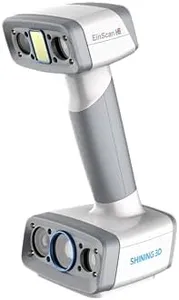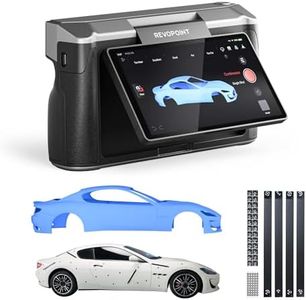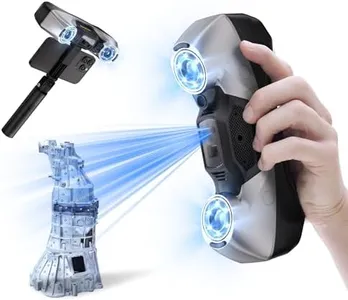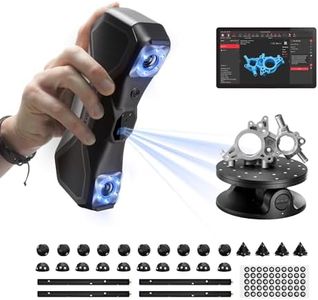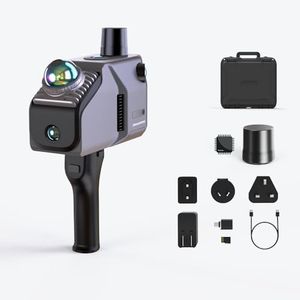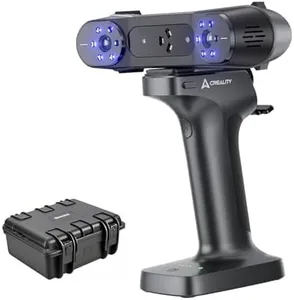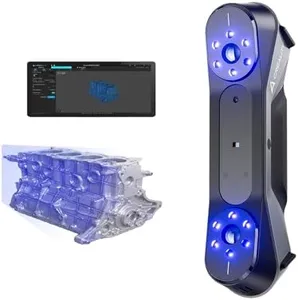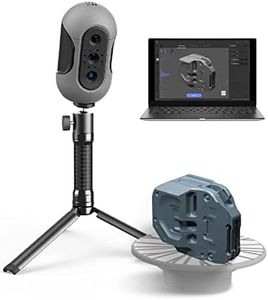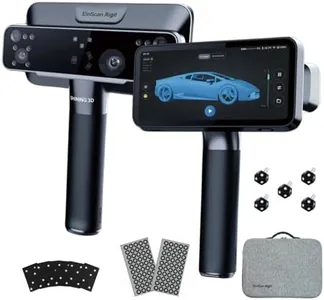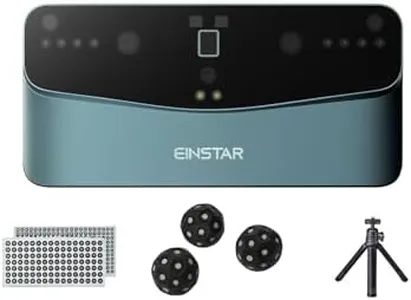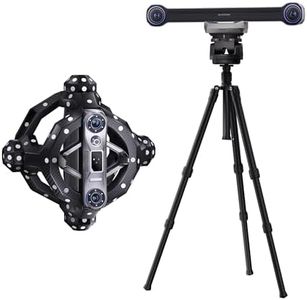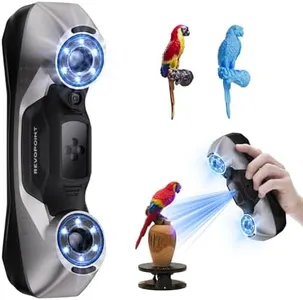10 Best 3D Scanners 2025 in the United States
Our technology thoroughly searches through the online shopping world, reviewing hundreds of sites. We then process and analyze this information, updating in real-time to bring you the latest top-rated products. This way, you always get the best and most current options available.

Our Top Picks
Winner
EinScan Pro HD Handheld 3D Scanner with Industrial Pack, Color Pack, Solid Edge Shining3D CAD Software, 0.2mm Resolution, 0.04mm Accuracy for Reverse Engineering, 3D Modeling, Art, Design, Healthcare
The EinScan Pro HD Handheld 3D Scanner is a versatile tool that suits users needing detailed and accurate 3D scans for applications like reverse engineering, art, and healthcare. It offers impressive resolution with a minimum point distance of 0.2mm, which means it can capture fine details without needing extra markers. Accuracy is another strong point, reaching up to 0.04mm in fixed scanning mode, ensuring high-quality 3D models. The scanner covers a wide range of object sizes—from very small (around 1 inch) to quite large (up to 10 feet)—making it flexible for various projects.
The inclusion of color scanning adds value by capturing full-color textures along with shapes, which helps in creating more realistic models. The bundled Industrial Pack with tripod and turntable adds stability and convenience for scanning different objects, while the Solid Edge CAD software enhances compatibility for design and engineering workflows. The scanner weighs about 2.36 pounds and measures around 6 x 10 inches, so it remains fairly portable but might not be the lightest option for all-day handheld use. Although specific scan speed details are not emphasized, the product highlights efficiency through texture alignment without extra preparation.
This device is well suited for users who need a dependable, high-detail scanner with strong software support and multi-functionality. New users, however, may experience a learning curve when working with the advanced features and setup included in the Industrial Pack.
EinScan H2 Handheld 3D Scanner Pro- High Texture Resolution 3D Scanner for 3D Printing with Built-in Color Camera, Handheld Infrared Light for IR Mode, Shining Version CAD Software Compatible
Most important from
7 reviews
The EinScan H2 Scanner is a versatile handheld 3D scanner tailored for professional use in 3D printing and modeling. Its standout feature is the high-resolution 5MP texture camera, which captures photorealistic textures, making it ideal for detailed and accurate models. The hybrid LED and infrared light source enables the scanner to work effectively on various surfaces and in different lighting conditions, enhancing its usability in diverse environments.
This is particularly beneficial for scanning dark objects and human bodies, offering up to 0.05 mm accuracy and 0.2 mm resolution for intricate detail capture. Additionally, the use of invisible infrared light ensures safe and comfortable scanning, especially for human subjects, making it suitable for projects requiring lifelike models. The scanner is lightweight, weighing 703 grams, and comes with essential software like SolidEdge CAD and ExScan H, along with a durable carrying case, ensuring it's a complete package for professionals.
The scanner’s reliance on USB connectivity may limit its flexibility for some users. Furthermore, the 60 watts power requirement might be on the higher side for those looking for energy-efficient devices. These minor drawbacks aside, the EinScan H2 stands out as a robust tool for professionals needing high precision and detail in their 3D scanning tasks.
Most important from
7 reviews
Revopoint MIRACO Plus 3D Scanner for 3D Printing Handheld, 3D Printer Scanner with Photogrammetry, Up to 0.02mm Precision, Full-Color Scan for Small to Large Objects, 32GB RAM
Most important from
56 reviews
The Revopoint MIRACO Plus is a versatile 3D scanner designed to handle small to large objects with impressive precision and color accuracy. It offers a very fine measurement accuracy of up to 0.02 mm, supported by photogrammetric metrology and coded targets that help capture detailed measurements even on complex surfaces. Its quad depth camera system adds flexibility by allowing scans of tiny parts or large machinery with modes optimized for different distances. The 48MP RGB camera combined with infrared laser technology ensures high-quality, full-color scans that look lifelike.
In terms of speed, the scanner can operate in a precise single-shot mode or a faster continuous mode capturing up to 20 frames per second, which makes it efficient for various scanning tasks. Portability is a strong point here, as the device weighs just 750 grams, is handheld-friendly, and has a 2-hour battery life with quick charging, making it suitable for scanning on the go.
The MIRACO Plus comes with powerful internal hardware, including an 8-core processor and 32GB RAM, enabling smooth handling of large scan files and up to 10,000 frames without lag. It supports multiple popular file formats and is compatible with both Windows and Mac systems, easing integration into different workflows. The included software is user-friendly and supports comprehensive functions like scanning, editing, merging, and converting scans into CAD models, which benefits both beginners and professionals.
The scanner’s resolution is 2 megapixels, which, while sufficient for many applications, might not match the ultra-high resolutions of some specialized scanners. The device is relatively compact but requires some familiarity with photogrammetric targets and calibration boards for the highest accuracy, which could have a slight learning curve.
The Revopoint MIRACO Plus is a strong choice for users needing detailed, color-accurate 3D scans across different object sizes, especially suited for 3D printing, reverse engineering, and design work. Its portability and software support make it accessible, though those needing ultra-high resolution or scanning very large objects should consider these factors carefully.

